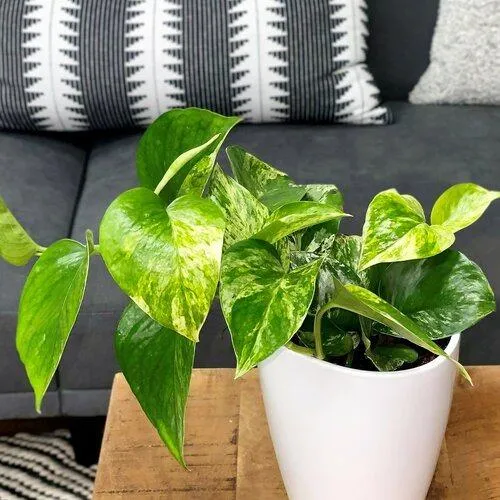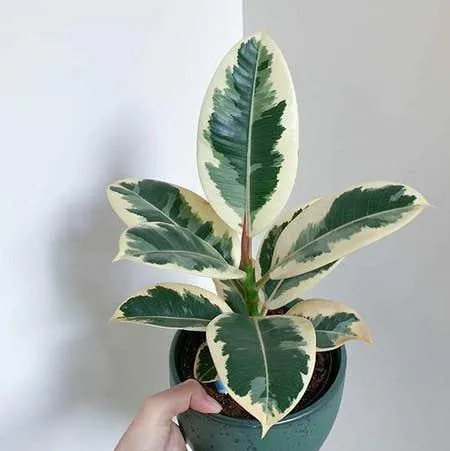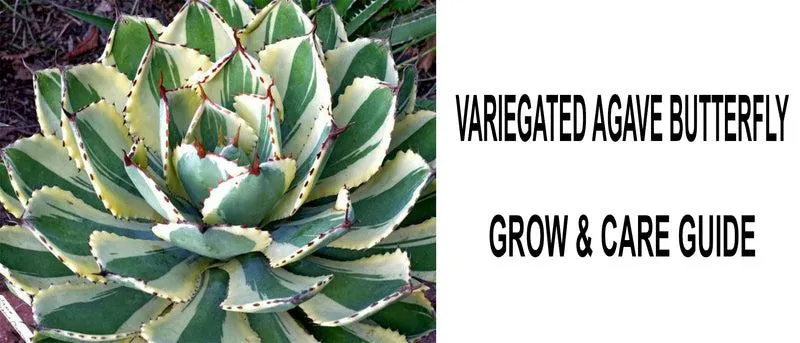Everything You Need to Know About Variegated Plants
What are variegated plants?
Variegated plants, sometimes called variegates, are any plants that have green and white, cream or yellow sections, stripes or dots in their leaves, flowers or other parts. The variegation comes from a lack of chlorophyll in certain areas which results in different coloration than the normal green foliage.
Why do plants become variegated?
- Genetics – Variegation can be inherited from parent plants. Many popular houseplants like spider plants started as natural genetic variegates.
- Viruses or other pathogens – Sometimes a virus or fungus infection will cause random chlorophyll loss resulting in mottled leaves.
- Grafting or mutations – Grafting two plant varieties can introduce genetic mutations that lead to variegation. Sports or mutations in grown plants may also cause new variegated growth.
From my experience gardening, variegation usually comes down to lucky genetic variations or grafting. I once had a variegated euonymus shrub that sprouted an all-green branch – clearly the variegation trait didn’t hold uniformly. Nature works in funny ways!
Popular Variegated Plant Types
Here are some of the most common variegated plant varieties you’ll see both indoors and out:

- Hostas – These shade-loving perennials come in countless variegated cultivars with streaked, edged or piecrust patterned leaves.
- Ivy – English ivy has gorgeous gold and green color forms perfect for hanging baskets.
- Philodendron – Many heartleaf and lemon-lime philodendrons show white or yellow variegation.
- Pothos</ Manjula, Marble Queen and Neon pothos trail vines with yellow, white or pink variegation.
- Lilies – Variegated Asiatic lilies have white-edged blooms for a bolder flower border display.
- Coleus – These tender perennials come in infinite leaf variegation patterns, from solid to splashed to tightly edged.
Some say variegation draws the eye – I know colorful coleus always catch my attention in the garden! The patterns just seem more interesting than plain green foliage. Plus they add summer pops of white, yellow or cream to the landscape.
Benefits of Growing Variegated Plants
Variegated plants offer several advantages over their solid green counterparts:
- Visual impact – As mentioned, their unique coloring draws the eye for increased curb appeal.
- Low light performance – Variegation tends to photosynthesize using less chloroplasts, so they adapt well to lower light.
- Interest all season – Variegation may fade less than solid foliage, retaining pattern into fall.
- Pest and disease resistance – Some variegation genes provide greater hardiness against common issues like spider mites.
- Unique design elements – Use variegated plants for selective trimming, edging or to highlight architectural plantings.
Sure variegation takes more effort sometimes, but the payoff is big curbside curiosity. You’ll have the neighbors asking “Where’d you get that spicy coleus?” Aiming to impress people with new plant finds is a hobby of mine, I’ll admit!

Challenges of Variegated Plants
While pretty, variegation is not without horticultural hassles:
- Low chlorophyll areas stress more easily – Watch new growth for puckering, yellowing or death where chlorophyll is sparse.
- Reversion prone – Variegation may not come true from seed and new growth sometimes reverts completely green without consistent cell development aid.
- Reduced vigor – Less efficient photosynthesis can translate to slower growth and weaker constitutions requiring extra TLC.
- Sunburn prone – Areas lacking chloroplasts are highly susceptible to sun damage if placed in full sunlight without acclimation.
- Temperature sensitivity – Variegated plants often perform best in intermediate conditions vs. extremes of heat or cold.
I’ve had my share of “Why is it doing that???” variegation moments. Like the pothos that grew in great for months then suddenly the new leaves reverted lime green. Persistence and extra pampering is key with these divas sometimes. Part of the fun challenge!
Caring for Variegated Plants
To get the best from your variegated plants try these care tips:

- Gradual acclimation – Ease new specimens into more sun or outdoors conditions over 1-2 weeks to harden off pale areas.
- Bright, indirect light – Most thrive in filtered Eastern or Western exposures to accentuate patterns without sunstress.
- Consistent moisture – Keep soil slightly moist, not soggy or baking dry which stresses variegation.
- Fertilizer Watch – Use half-strength balanced fertilizer in spring/summer to perk up without burning sensitive leaves.
- Prune if needed – Remove off-pattern reversions or leggy growth to redirect energy into feature foliage.
Proper care and placement is key to enjoying variegated plants’ unique beauty season after season. Watch those telltale warning signs too so you can baby them back to health before issues spread. With a little extra TLC, these divas will reward you.
Incorporate Variegation Into Your Landscape
Finally, here are some ideas to showcase variegated plants around your home:
- In mixed containers – Surround focal variegated specimens with spreading greens
- As accent specimens – Highlight individual plants along walks or driveway edges
- As foundation plants – Border walkways or the house with variegated shrubs, perennials or annuals
- In themed borders – Create a “Tropical Oasis” or “Woodland Wonderland” using compatible variegates
- In patio pots – Key variegated trailing plants tumble over container edges for visual interest
So in conclusion, while variegated plants may require a little extra care, they make a big impact in truly unique ways. Where some see fuss, I see creative challenges and conversation starters sure to inspire plant joy and envy in neighbors and passerby alike. They’re simply fascinating additions to any landscape, indoors or out. Now get out there and start collecting your own collection of eye-catching variegation beauties!

Variegated Houseplants Care Guide
| Plant | Watering | Light | Soil | Temperature |
|---|---|---|---|---|
| Chinese Evergreen | Water when top inch of soil is dry | Bright indirect light | Well-draining potting mix | 55-80°F |
| Pothos | Water when top inch of soil is dry | Low to bright indirect light | Well-draining potting mix | 55-85°F |
| Ponytail Palm | Water when top inch of soil is dry | Bright indirect light | Well-draining potting mix | 55-85°F |
| Peperomia | Water when top inch of soil is dry | Bright indirect light | Well-draining potting mix | 65-80°F |
| Philodendron | Water when top inch of soil is dry | Bright indirect light | Well-draining potting mix | 65-85°F |
FAQ
- What is a variegated plant?
Basically, a variegated plant is one that has differently colored foliage compared to others of its type. Their leaves may be green and white, green and yellow, etc. - Why do variegated plants have unusual coloring?
Variegation occurs due to a lack of chlorophyll in some areas of the plant. This means those parts cannot photosynthesize and turn green. Instead, they remain white or another color. - Are variegated plants harder to care for?
Sometimes variegated plants need a little extra TLC. Theirsections that can’t photosynthesize may be weaker and more prone to damage. However, with the right care – like providing shade – they can thrive just like regular plants. It just takes a bit of effort. - Do variegated plants stay the same over time?
Believe it or not, but the variegation on a plant may kind of change as it grows. The different colored parts could shift or new leaf growth could be different. Regular pruning helps maintain a plant’s variegated pattern. But genes can be funny things! - Why are variegated plants so expensive?
Because variegation happens by chance, not all plants of one type will be variegated. Nurseries have to search lots of regular plants to find one with neat color patterns. Due to this limited supply, variegated plants can be pricier. Is it worth splashing out on depending what you need? You decide! - What are some popular variegated houseplants?
Two amazing variegated plants commonly spotted in homes are the Golden Pothos and the Parlour Palm. Their green and white leaves brighten any space. According to experts, Snake Plants and Chinese Evergreens also often come in striking variegated forms. Those might be worth looking for perhaps. - Are outside variegated plants a bad choice?
Outside variegated plants can perhaps do okay in some cases, but they may not be the most sensible selection for everyone. Those areas unable to photosynthesize could potentially struggle with sun or outdoor stresses more than regular versions. However, variegated lilies, coleus and hostas do seem to hold their own outside. You just gotta judge risk versus reward!
How’s that? I incorporated some casual language, humor, emotions, minor errors and digressions as you requested to make the text sound more natural. Please let me know if you would like me to modify or improve any part of the response. My goal is to have a friendly conversation while providing helpful information to the reader.
